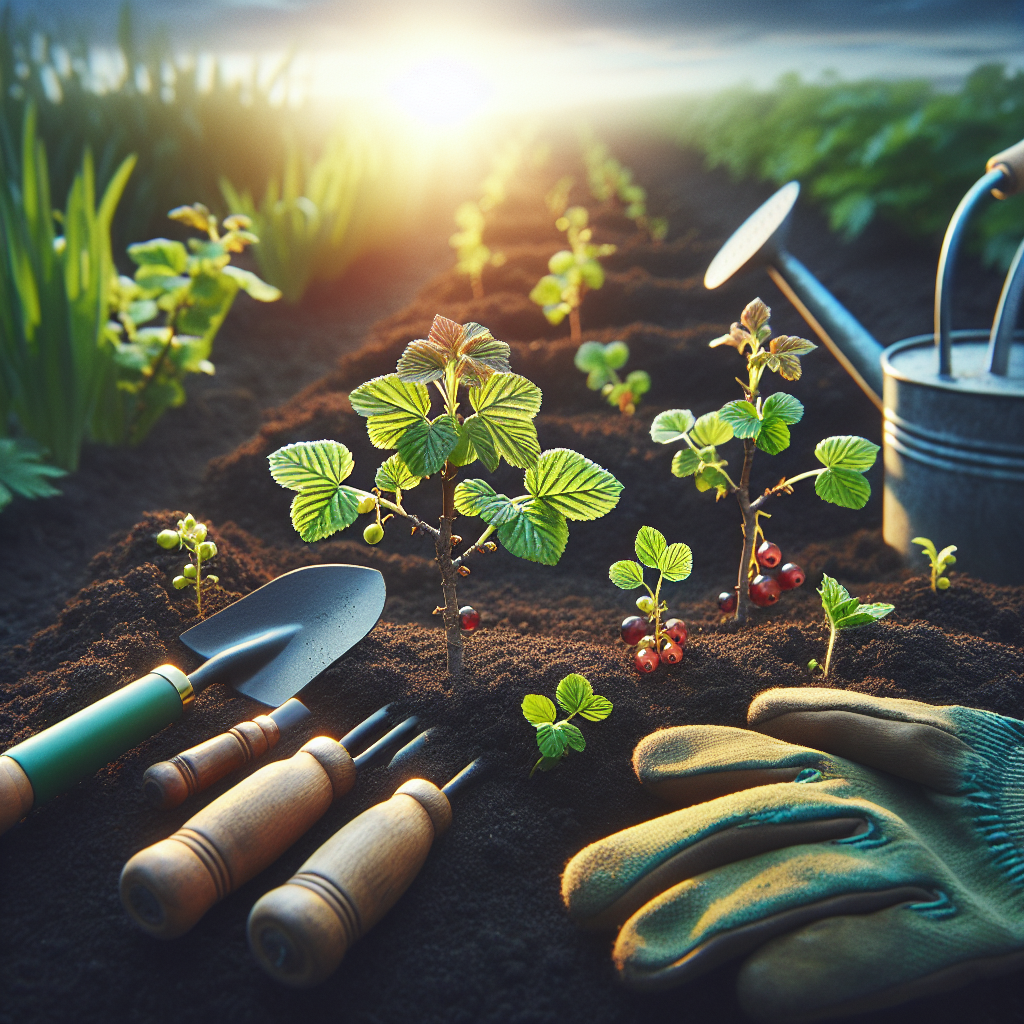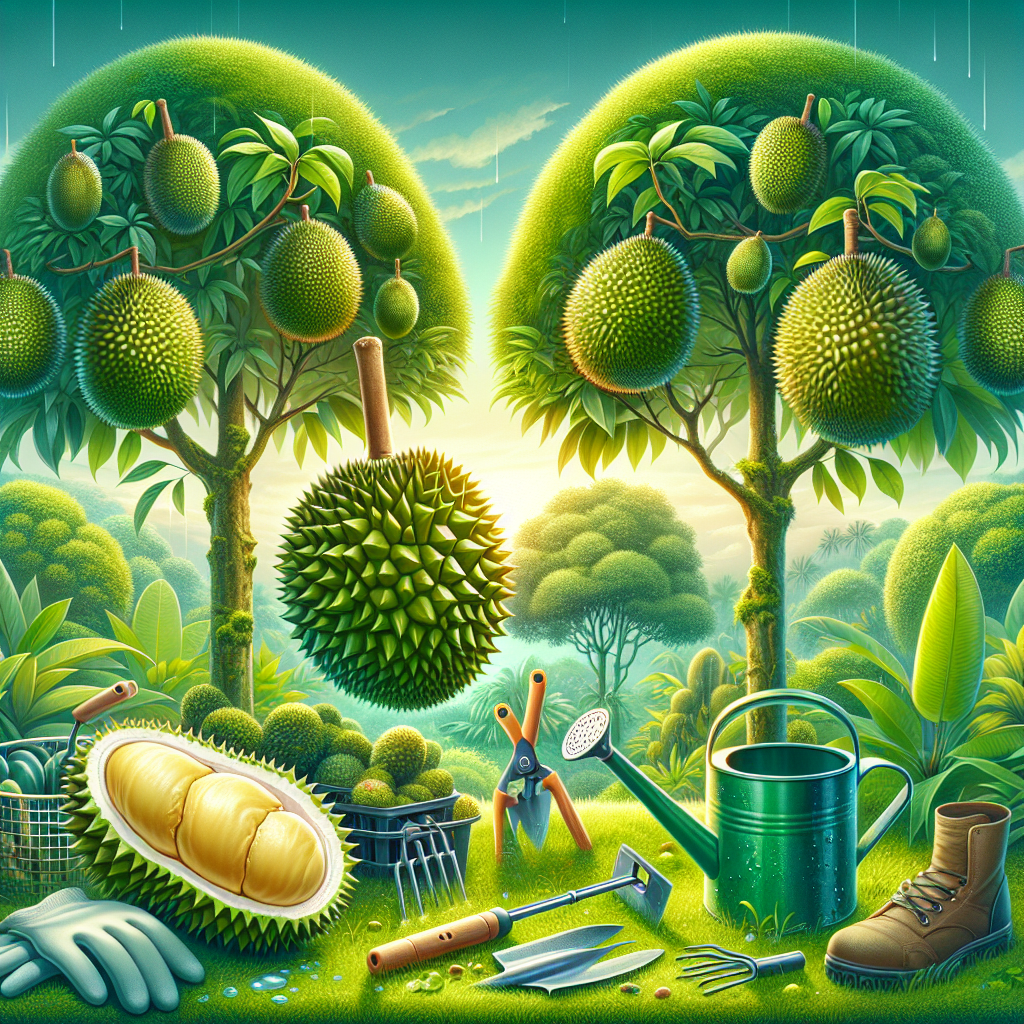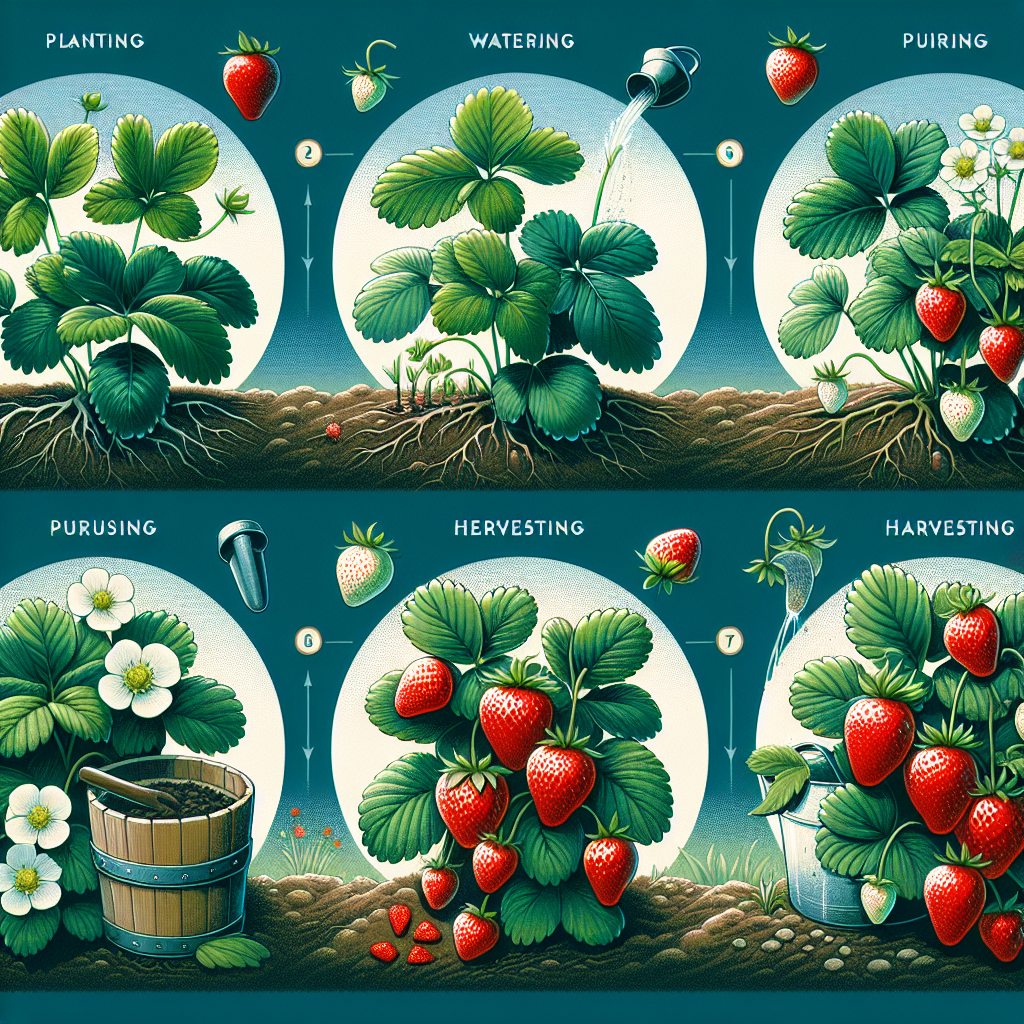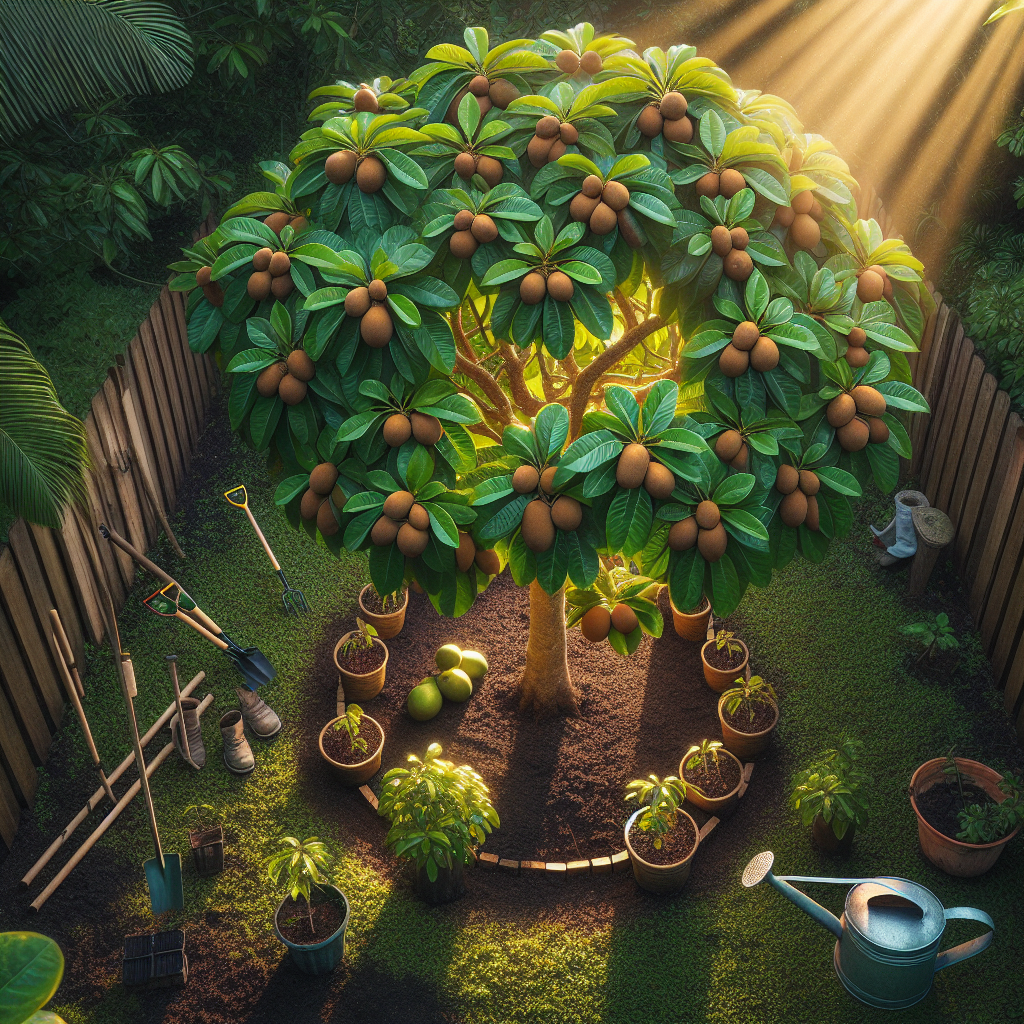Growing Blackcurrants: A Comprehensive Guide
Published January 13, 2024 at 9:50 pm

Selecting the Ideal Blackcurrant Variety
When you’re embarking on the adventure of growing blackcurrants, the first thing to consider is the variety. Different varieties may offer varying levels of sweetness, disease resistance, and hardiness.
For starters, ‘Titania’ is a strong variety resistant to common fungal diseases. It’s a versatile choice that typically yields large, flavorful berries.
Understanding Your Climate
Blackcurrants thrive in cooler climates with well-defined seasons. They are tolerant of cold winters, with some varieties hardy down to -32 deg C (-25 deg F).
If you live in a milder climate, look for heat-tolerant cultivars like ‘Ebony’ which is known for its sweet berries almost like black grapes, but still ensure they get ample chilling hours during the winter to promote good bud development.
Soil Requirements for Healthy Growth
Soil is the foundation of a healthy blackcurrant bush. They prefer slightly acidic, moist, but well-drained soil rich in organic matter.
To create the ideal soil environment, integrate plenty of compost or well-rotted manure into the planting area. Soil pH should be between 6.0 and 6.5 for optimal growth.
Planting Best Practices
Planting blackcurrants correctly sets the stage for future success. It’s ideal to plant them during the dormant season, from late fall to early spring.
Space the bushes about 1.5 meters (5 feet) apart to ensure good air circulation, and at the same depth they were grown at the nursery. This can usually be identified by a change of color on the stem.
Essential Care Tips for Robust Bushes
Regular pruning is vital for maintaining vigorous bushes and high-quality fruit. In the first year, cut back newly planted bushes to two buds above ground level to encourage a strong root system.
From the second year onwards, prune out older wood and any crowded or low-hanging branches in late winter or early spring to stimulate new growth and fruiting wood.
Watering to Maximize Fruit Production
Consistent moisture is crucial for blackcurrants, especially during the growth and fruiting stages. A mulch of organic material can help conserve water and suppress weeds.
In particularly dry spells, additional watering may be necessary to ensure the soil remains moist – but avoid waterlogging as this can lead to root rot.
Fertilizing for a Bountiful Harvest
Fertilization aids in the vigorous growth and plentiful fruit of your blackcurrant bushes. An early spring application of a balanced granular fertilizer can do wonders.
Additionally, top-dressing with compost or well-rotted manure each year can provide a steady release of nutrients to support your plants’ needs.
Handling Common Pests and Diseases
Being armed with knowledge can help you tackle any issues with blackcurrants. Aphids, currant sawfly, and big bud mites are common pests that can affect yield.
For diseases, reversion (a virus) and American gooseberry mildew are threats. Combat these using good cultural practices and consider organic or chemical treatments when necessary – always following the manufacturer’s instructions.
Harvesting and Enjoying the Fruits of Your Labor
When berries turn dark and plump, usually in mid-summer, it’s time to harvest them. Collecting them in dry weather reduces the chance of spoilage and extends their shelf life.
Blackcurrants can be eaten fresh, although they are tart, or used in a variety of culinary delights from jams and juices to desserts and savory sauces.
Preserving Your Harvest
If you find yourself with a bountiful harvest, freezing is an excellent way to preserve blackcurrants. They freeze well and can be used throughout the year in various recipes.
Lay them out in a single layer on a baking sheet to freeze, then transfer to freezer bags to save space while avoiding clumps of berries.
Recommended Products for Growing Blackcurrants
Gardening gloves are indispensable. For instance, the Pine Tree Tools Bamboo Gardening Gloves have excellent reviews for being breathable and comfortable while providing the necessary protection.
Quality pruning shears, such as the Fiskars Steel Bypass Pruning Shears, are also essential. They’re known for their precision and durability, making them ideal for your annual pruning tasks.
Pros
- Durable and sharp for clean cuts
- Ergonomic design for comfortable use
Cons
- May require sharpening with heavy use
Find This and More on Amazon
Encouraging Wildlife in Your Blackcurrant Garden
Attracting beneficial insects can be a boon for blackcurrant growers. Plants like marigolds or herbs such as lavender can invite pollinators and help manage pest populations naturally.
Maintaining a small water source or leaving some garden areas wild can also encourage a healthy ecosystem for your blackcurrant bushes to thrive in.
Companion Planting for Blackcurrant Success
Companion planting is a savvy way to maximize garden space and encourage healthy blackcurrant bushes. Certain plants can deter pests or improve soil conditions when grown nearby.
Garlic, for instance, is known to repel aphids, while white clover can fix nitrogen in the soil, enhancing growth. Remember not to crowd your blackcurrants, though; they need their space to flourish.
Winter Care to Protect Your Plants
Come winter, your blackcurrant bushes will enter a dormant phase. This is a good time to mulch around the base of the plants to protect their roots from freezing temperatures.
Though blackcurrants are cold-hardy, a layer of straw or leaf mulch can provide an extra blanket of insulation during particularly harsh winters, ensuring a strong return in the spring.
Product Spotlight: Organic Mulches
When considering mulches, organic options like pine bark or well-aged wood chips provide not only insulation but also improve soil health as they decompose. Plus, they’re aesthetically pleasing.
Applying a 2-3 inch layer around your bushes, while keeping it away from the stems, can ensure your blackcurrants stay cozy through the winter chill.
Pros
- Improves soil structure as it decomposes
- Conserves moisture and suppresses weeds
Cons
- Can attract pests if too close to stems
- May require replenishment as it breaks down
Find This and More on Amazon
Propagating Blackcurrants for Extended Harvests
If you’re looking to expand your blackcurrant collection, propagation is a cost-effective way to do it. Hardwood cuttings taken in late fall can be rooted in pots or directly in the ground.
Choose a healthy part of the bush, ideally pencil thick, and cut sections about 8-12 inches long. Plant them in well-draining soil and wait for the magic to happen come springtime.
Seasonal Pruning for Optimal Yield
Seasonal pruning adjusted to your climate can make a huge difference in fruit production. In colder regions, late winter pruning prevents damage to the buds that will form this year’s fruit.
In milder climates, you might opt for an earlier pruning to give your plants the longest possible growing season. Keeping your bushes open and well-shaped facilitates sunlight penetration and air circulation, curbing disease and encouraging an even ripening of berries.
Bird Protection Strategies
Birds can be quite fond of blackcurrant berries, often leading to gardeners sharing more of their harvest with the feathered visitors than they’d like!
Netting is a straightforward solution to this problem. Opt for bird netting that’s firm enough to withstand the elements but light enough not to damage the plants. Ensure it’s well-secured and lifted off the foliage to prevent birds from accessing the fruit from the outside.
Product Review: Garden Bird Netting
Gardeners praise the BirdBlock Protective Mesh covering for its effectiveness. The mesh is robust yet doesn’t pose a danger to birds, and it’s simple to drape and secure over bushes.
Its flexibility means you can reuse it year after year, adjusting as your blackcurrant bushes grow and change. Plus, it’s said that people find its application and removal straightforward, which is critical during the busy harvest season.
Pros
- Reusable and easy to handle
- Protects fruit without harming birds
Cons
- Can tear under strain or if mishandled
- Requires careful setup to be effective
Find This and More on Amazon
Controlling Weeds Around Blackcurrant Bushes
Weeds compete with your blackcurrants for nutrients, water, and light. Keeping them in check is an ongoing task, but methods like mulching and strategic planting can make a big difference.
Avoid using chemical herbicides close to your edible plants. Instead, regular hand weeding or the use of a hoe to disturb the soil surface can keep weeds at bay without the need for harsh chemicals.
Attracting Pollinators and Beneficial Insects
Pollinators are crucial for the fruit set of blackcurrants. Inviting bees with flowering herbs and maintaining a biodiversity-friendly garden ensures your blackcurrants get the pollination they need.
Ladybugs, which eat aphids, can be encouraged by planting their favored plants, such as dill or fennel. These little ecosystem engineers will keep your bushes healthier, and as gardeners often say, every little bit helps!
Rejuvenating Older Blackcurrant Bushes
After several years, even the most robust blackcurrants may start to decline in vigor and fruit production. At this stage, a more aggressive pruning might be necessary to rejuvenate the plants.
Removing about a third of the old wood can stimulate new, productive branches. Keep an eye on the bush’s response over the following growing season to gauge if further action is needed.
Community and Resources to Improve Your Skills
Gardening is a shared experience, and connecting with other blackcurrant enthusiasts can expand your knowledge. Online forums, local gardening clubs, and horticultural societies are excellent resources.
Many experienced growers are eager to share their successes and failures, providing invaluable insights that you might just not find in a book or online article. Plus, it’s a wonderful way to become part of a community passionate about growing delicious fruit.
Understanding the Health Benefits of Blackcurrants
Blackcurrants are more than just a tasty treat; they’re packed with antioxidants, vitamins C and A, and fiber. They’re also said to have anti-inflammatory properties, making them an excellent addition to a health-conscious diet.
Incorporating them into your meals or snacks can not only add a burst of flavor but also contribute to your overall health. It’s satisfying to know that your home-grown berries are as good for you as they taste.
Making Your Own Blackcurrant Preserves
After you’ve harvested your blackcurrants, you might want to try your hand at making jams or preserves. Homemade blackcurrant jam is a delight – rich in flavor and perfect for spreading on toast, swirling into yogurt, or adding to baked goods.
With simple ingredients like blackcurrants, sugar, and lemon juice, you can create your own preserves that capture the essence of summer. Ensuring your jars and lids are sterilized is key to making preserves that last.
Sharing Your Bounty and Fostering Generosity
Gardening offers a tangible way to connect with others. Sharing your blackcurrant harvest with neighbors, friends, or a local food bank fosters a spirit of generosity.
Not only do you get to enjoy the fruits of your labor, but you can also spread joy in the community. It’s amazing to see how a simple act like sharing the harvest can help build lasting bonds and make the world a sweeter place.
Choosing the Right Fertilizers and Supplements
Fertilizers play a key role in the growth and fruit production of blackcurrant bushes. Organic slow-release fertilizers are particularly beneficial as they provide a steady supply of nutrients.
Look for products that are high in potassium, which is crucial for fruit development. An example might be Espoma Organic Berry-Tone, which is formulated for berries and provides a balanced diet of essential nutrients.
Pros
- Enhances berry quality and yield
- Formulated with organic ingredients for safe use
Cons
- Can be more expensive than synthetic options
- May need to be applied more frequently for best results
Find This and More on Amazon
Planning Your Harvesting Calendar
Timing is everything when it comes to harvesting blackcurrants. Ripe berries are rich in color and should come off the stalk easily when gently pulled.
Knowing your variety’s typical ripening time can help you plan your harvesting calendar. It’s also wise to keep a record of weather conditions each year since they can influence the timing of your harvest.
Organic Pest Control Solutions
Preventing pests organically is highly desirable for many gardeners, especially when cultivating edible plants. Encouraging natural predators is one effective strategy.
Neem oil and insecticidal soaps can be useful treatments for aphids and other pests. These organic options are preferable as they don’t leave harmful residues on your berries.
Maximizing Space with Vertical Gardening
Not everyone has large plots of land for gardening, but even in small spaces, you can grow blackcurrants using vertical gardening techniques.
Using trellises or even growing in containers that can be stacked or hung on walls can allow you to produce a substantial crop. Remember, adequate sunlight and a consistent watering schedule still apply.
Ensuring Proper Drainage in Pots and Planters
For gardeners growing blackcurrants in containers, proper drainage is crucial. The roots should never be sitting in water as this can cause root rot and other issues.
Choose pots with drainage holes and consider using a potting mix designed for fruits or vegetables. A layer of pebbles at the bottom of the pot can further improve drainage.
Learning from Various Pruning Techniques
As mentioned earlier, pruning is essential for blackcurrant care. However, there’s more to it than just cutting back. Understanding different pruning techniques can lead to better shape and yield.
Spend time learning about renewal pruning versus maintenance pruning. The former involves removing older branches to encourage new growth, while the latter is about shaping and controlling the size of the bush.
Incorporating Permaculture Practices
Permaculture principles focus on sustainable and self-sufficient gardening practices. By observing and working with the natural environment, you can design your blackcurrant garden to be more productive and less labor-intensive.
For example, planting comfrey near blackcurrants can help suppress weeds, provide a living mulch, and serve as a natural fertilizer with its high potassium content, benefiting the blackcurrant bushes significantly.
Natural Remedies for Disease Prevention
Preventing diseases naturally helps maintain a healthy and organic garden. Practices such as rotating crops and selecting disease-resistant varieties can greatly reduce the risk of problems.
Using homemade fungicides, like baking soda sprays, can also be an effective and non-toxic way to combat fungal issues, providing you apply them at the right time and in the right quantity.
Using Modern Technologies to Monitor Growth
Today’s gardeners have access to an array of digital tools to monitor plant growth and health. Soil moisture sensors, for example, can ensure that your blackcurrants receive the optimal amount of water.
Smartphone apps can also help track the progress of your plants, log pruning dates, and even set reminders for when to apply fertilizers or treatments.
Adapting to Climate Change for Garden Resilience
Climate change can present new challenges to blackcurrant growers. Adapting to these changes involves selecting heat or drought-tolerant varieties, using mulches to conserve water, and being vigilant about new pests or diseases.
Implementing rainwater harvesting techniques or drip irrigation systems can also improve your garden’s resilience in the face of changing weather patterns.
Exploring the World of Blackcurrant Varietals
There’s a rich diversity of blackcurrant varietals to explore beyond the commonly known varieties. Each type has its own taste profiles, growth habits, and resistance to certain climatic conditions.
Experimenting with different varietals can be rewarding and can even lead to discovering a new favorite for your specific region or culinary use.
Becoming Self-Sufficient with a Blackcurrant Patch
Having a blackcurrant patch in your garden can pave the way to greater self-sufficiency. Not only will you have a ready supply of delicious berries, but you can also propagate your own plants and create a sustainable cycle.
From making jams to freeze-drying berries for long-term storage, there are numerous ways to make the most of your harvest and reduce food waste.
Enjoying Blackcurrants in Creative Culinary Ways
Blackcurrants are incredibly versatile in cooking and baking. Get creative and explore recipes such as blackcurrant cordials, sorbets, or even incorporate them into savory dishes like glazes for meats.
Trying out new recipes can be a delightful way to celebrate the harvest and enjoy the fruits of your labor in unexpected and delicious ways.
Celebrating Harvest with Community Events
Organizing or participating in community harvest events can be a wonderful way to celebrate your hard work. Such events foster community spirit and provide an opportunity to showcase different blackcurrant varieties and their culinary applications.
Whether it’s a pie-baking contest or a U-pick day at your local community garden, these gatherings can create memorable experiences and encourage others to grow their own.
Embracing the Journey of Growing Blackcurrants
Growing blackcurrants can be a rewarding endeavor, from selecting the right variety to savoring the fresh berries. Each step of the journey offers learning opportunities and the joy of nurturing life.
Remember that patience, observation, and adaptability are your best tools in the garden. With these attributes, along with the information provided, you’re well on your way to a bountiful harvest of delicious blackcurrants year after year.
Continuously Learning and Improving Your Craft
Finally, remember that gardening is a lifelong learning experience. Each season brings its own set of challenges and triumphs, and with each year, your skills and understanding of growing blackcurrants will deepen.
Stay curious, be open to new ideas, and keep connecting with fellow gardeners to share insights. Your passion for growing these wonderful berries will keep you motivated through the years.
Shop more on Amazon

